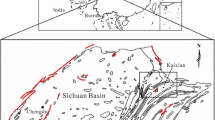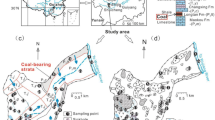Abstract
Two springs (Cuihua Spring, Shuiqiuchi Spring) in Cuihua Mountain of the Qinling Mountains were observed and sampled monthly during 2004 and 2005 to trace their physical properties and chemical compositions with seasons. Although both pH values and cation (Ca2+, Mg2+, K+, and Na+) contents of Cuihua Spring are higher than those of Shuiqiuchi Spring, seasonal variations in both springs are obvious. The pH values of both spring waters are between 5.69 and 6.98, lower than that of rainwater during summer and autumn. From January to November, the pH values of both springs similarly vary from high to low and then to high again. Variations in electric conductivities of two spring waters are contrary, although their electric conductivities are positively correlative with the cation content respectively. This can be attributed to different water sources of the two springs or different acidic rocks they passed. The contents of HCO3 −, Ca2+, Mg2+, K+, and Na+ are low, indicating a low silicate weathering that the strata in this district are mainly composed of granite and schist of quartz and mica. Differing from change in spring water in karst regions of South China where abundant precipitation and dilution of rainwater cause low pH and electric conductivity in summer and autumn, the seasonal variations in the pH values and the electric conductivities of two springs in Qinling Mountains are attributed to seasonal changes in CO2 produced by microorganisms’ activity in soil within respective year, rather than rainfall. The microorganisms’ activity in soil produces more CO2 during summer and autumn. Therefore, the water nature of springs in silicate regions chiefly reflects the seasonal changes of CO2 produced by the microorganisms in soil.





Similar content being viewed by others
References
Banner JL, Musgrove M, Capo R (1994) Tracing ground-water evolution in a limestone aquifer using Sr isotopes, effects of multiple sources of dissolved ions and mineral-solution reactions. Geology 22:687–690
Boeglin JL, Probst JL (1998) Physical and chemical weathering rates and CO2 consumption in a tropical lateritic environment: the upper Niger Basin. Chem Geol 148:137–156
Cao JH, Pan GX, Yuan DX et al (1999) Atmospheric CO2 dynamics in the Guilin karst depression ecosystem and environmental significance. Geol Rev 45(1):105–112
Cao JH, Yuan DX, Pan G et al (2001) Preliminary study on biological action in karst dynamic system. Earth Sci Front 8(1):203–209
Chen JS, He DW (1999) Chemical characteristics and genesis of major ions in the Pearl river basin. Acta Sci Nat Univ Pekinensis 35(6):786–783
Edmunds WM, Carrillo-Rivera JJ, Cardona A (2002) Geochemical evolution of groundwater beneath Mexico City. J Hydrol 258:1–24
Gaillardet J, Dupre B, Allegre CJ et al (1997) Chemical and physical denudation in the Amazon River basin. Chem Geol 142(3/4):141–173
He SY, Xu SY, Zhang ML (1997) Observation on soil CO2 concentration, hydrochemistry and their relationship with karst processes. Carsologica Sin 16(4):319–324
He SY, Pan GX, Cao JH et al (2000) Research on characteristics of carbon cycle in EPI-karst ecological system. Quatern Sci 20(4):383–390
Jiang ZC (1999) Elements’ migration in karst dynamical system. Acta Geogr Sin 54(5):438–444
Liu ZH, He SY, Yuan DX (1998) Soil CO2 and the drive process on karst process. Hydrogeol Eng Geol 25(4):42–45
Liu W, Wang T, Gao X et al (2004a) Distribution and evolution of water chemical characteristics in Heihe River Basin. J Desert Res 24(6):755–762
Liu ZH, Li Q, Wang JL (2004b) Interpretation of borehole storm-scale and vertical hydrochemical variations at the Guilin karst experimental site. Carsologica Sin 23(3):169–176
Liu Y, Liu DS, Shen LC (2007a) Hydrogeochemical characteristics and mechanisms of granite area in Weixi, Yunnan province. Geochimica 36(2):161–170
Liu ZH, Li Q, Sun H et al (2007b) Seasonal, diurnal and storm-scale hydrochemical variations of typical epikarst springs in subtropical karst areas of SW China: soil CO2 and dilution effects. J Hydrol 337(1–2):207–223
Sun X, Zhang W, Ma L et al (1995) Test of mechanism for mineral water in Panshan area. Geol Prospect Forum 10(1):85–93
Sun YY, Ji HB, Luo JM et al (2006) Hydro-geochemistry and chemical weathering processed of small watersheds in the southern Jiangxi province. Environ Chem 25(5):550–557
Velbel MA (1993) Temperature dependence of silicate weathering in nature: how strong a negative feedback on long-term accumulation of atmospheric CO2 and global greenhouse warming? Geology 21(12):1059–1062
White AF, Blum AE (1995) Effects of climate on chemical weathering in watersheds. Geochim Cosmochim Acta 59:1729–1747
Xi DL, Sun YS, Liu XY (2004) Environment monitoring. Higher education press, Beijing, pp 90–92
Xu JH, Ma CQ, Liu F et al (2002) Difference of granite weathering in south and north slope of Dabie Mountain and tectonic-climatic significance. Sci in China (series D) 32(5):415–422
Yuan DX (1997) Sensitivity of karst process to environmental change along the PEP II transects. Quatern Int 37:105–113
Yuan DX (2002) Chinese karst dynamic system. Geological Publishing House, Beijing, pp 20–45
Zhao JB (1996) Change in composition of karst spring and characteristics of karst development in Zhen’an and Xunyang counties of Shaanxi Province. Carsologica Sin 15(4):376–381
Zhao JB, Yuan DX, Xi LP (2000) Research on the modern karst processes and absorbed amount of CO2 in Bahe river catchment of Xi’an. Quatern Sci 20(4):367–373
Zhao JB, Du J, Yuan DX et al (2002) The release amount and its change law of CO2 from soils in Xi’an area. Environ Sci 23(1):22–25
Acknowledgments
This work was supported by the National Science Foundation of China (No. 40372117) and Karst Dynamics Laboratory, MLR (2006–07), State Key Laboratory of Loess and Quaternary Geology, Chinese Academy of Science (SKLLQG0605).
Author information
Authors and Affiliations
Corresponding author
Rights and permissions
About this article
Cite this article
Zhao, J., Wang, C., Jin, Z. et al. Seasonal variation in nature and chemical compositions of spring water in Cuihua Mountain, Shaanxi Province, central China. Environ Geol 57, 1753–1760 (2009). https://doi.org/10.1007/s00254-008-1460-4
Received:
Accepted:
Published:
Issue Date:
DOI: https://doi.org/10.1007/s00254-008-1460-4




